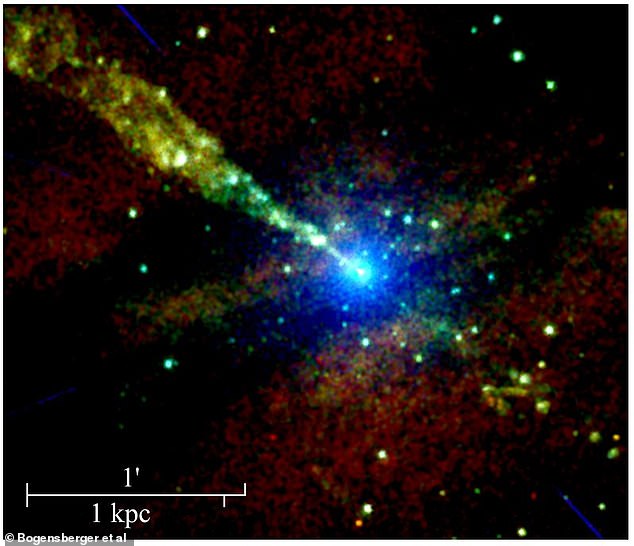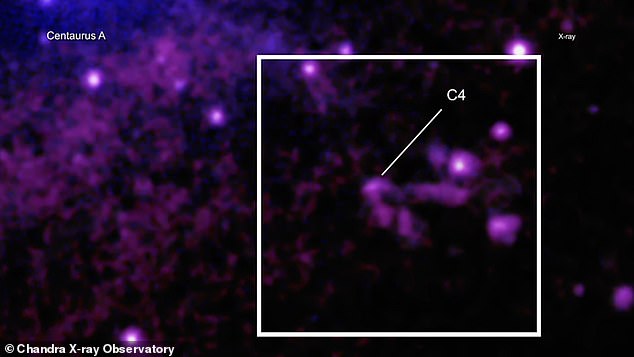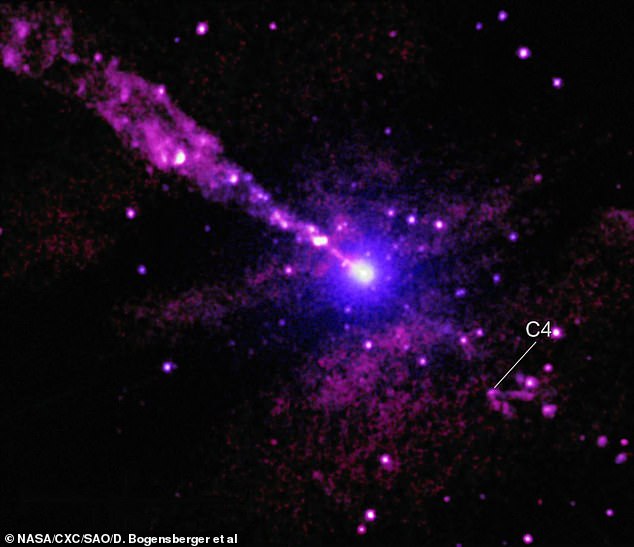They are some of the most unusual and fascinating objects in the universe.
And now a study suggests that black holes could be even stranger than we thought.
NASA’s Chandra X-ray observatory has captured huge jets of plasma from a supermassive black hole colliding with a mysterious object.
The researchers who made this strange discovery say they have no idea what this galactic accelerator could be or why it seems to act so strangely.
The hidden object lurks within the Centauri A galaxy, a jagged swirl of gas and dust approximately 12 million light years from Earth.
What makes Centaurus A so special is the supermassive black hole at its heart, which shoots radiation and matter 40,000 light years across the entire galaxy.
Using the deepest X-ray images ever taken of the galaxy, researchers found a V-shaped patch of bright emissions caused by the collision of these jets and some unknown object.
NASA says: “Although researchers have ideas about what is happening, the identity of the object being destroyed is a mystery because it is too far away for its details to be seen, even in images from today’s most powerful telescopes.” .
Scientists have made a puzzling discovery by detecting an unknown object being hit by the plasma jet of a supermassive black hole (pictured)

As black holes accumulate matter in an accretion disk, some of it accelerates and shoots out into space in the form of a large beam of plasma and radiation (artist’s impression).
When a star more than 20 times the size of our sun dies and explodes in a supernova, the remaining matter collapses into an extremely dense object called a black hole.
These mysterious voids exert a gravitational force so strong that nothing, not even light, can escape their pull.
As matter and light fall into the black hole like water surrounding a plug, they form a huge rotating ring called an accretion disk.
However, not all of that stuff ends up falling beyond the point of no return known as the event horizon.
Instead, some matter accelerates along black holes’ powerful magnetic field lines and shoots away from the poles at incredible speeds.
While scientists know roughly why these jets form, their nearly relativistic speed and intense forces make much of their true nature a mystery.
Located relatively close to Earth, Centaurus A has long been the ideal place to observe these mysterious jets in action.
In previous studies, NASA has detected a series of “jet knots” within the huge plumes of Centaurus A.

The Centauri A galaxy (pictured) is 12 million light years from Earth and is notable for the supermassive black hole at its heart that generated a 40,000 light-year plume of plasma.

Scientists have previously detected ‘jet knots’, which appear as bright spots of X-ray radiation in images.
These are massive areas of turbulence that appeared as bright spots in the X-ray spectrum.
But in this latest study, Dr. David Bogensberger, an astrophysicist at the University of Michigan, and his co-authors found a knot that didn’t match any of the usual patterns.
Dr. Bogensberger and his co-authors write: ‘Near the axis of the counterjet we detected a source with an unusual morphology. We label it C4.’
“It appears to have two streams of matter moving away from it at two different angles, forming a ‘V’ shape behind it.”
The arms of the V are at least 700 light years long, 140 times the distance between Earth and its nearest neighboring star.
The Vs of strong X-ray radiation behind C4 are unusual since all other obstacles in the path of the jet produce only elliptical spots.
NASA suggests that the mysterious object at the heart of this cosmic trail could be a massive star, either alone or accompanied by a companion star.
Researchers believe that particles from the black hole’s jet could be colliding with the strong solar winds emitted by this star.
If this were the case, the resulting turbulence would increase the density of the gas in the jet, triggering the X-ray emission seen in the Chandra images.
However, the unique structure of C4 poses some problems for this relatively simple explanation.

This study found an object known as C4 that had an unusual V-shaped trail extending behind it. This is totally different from the elliptical patterns typically produced by objects caught in a black hole’s jet.

Scientists believe that C4’s unique shape could be the product of a massive star. When particles from the jet collide with the star’s solar wind, this compresses the jet and ignites the bright X-ray radiation seen in these images.
If there were an object in the jet, astronomers would expect to see an X-ray trail that ran roughly parallel to the direction of the jet, like the wake around a ship moving upstream.
The lower arm of the V matches this image, but the upper arm is more difficult to explain as it is at a much greater angle to the jet.
That means that whatever this object is, it may have some very unusual properties that astronomers haven’t detected anywhere else in the universe.
NASA says: “Astronomers are trying to determine why C4 has this different appearance after contact, but it could be related to the type of object the jet hits or how directly it hits it.”
However, at least for now, the identity of this strange object will remain stubbornly mysterious.

